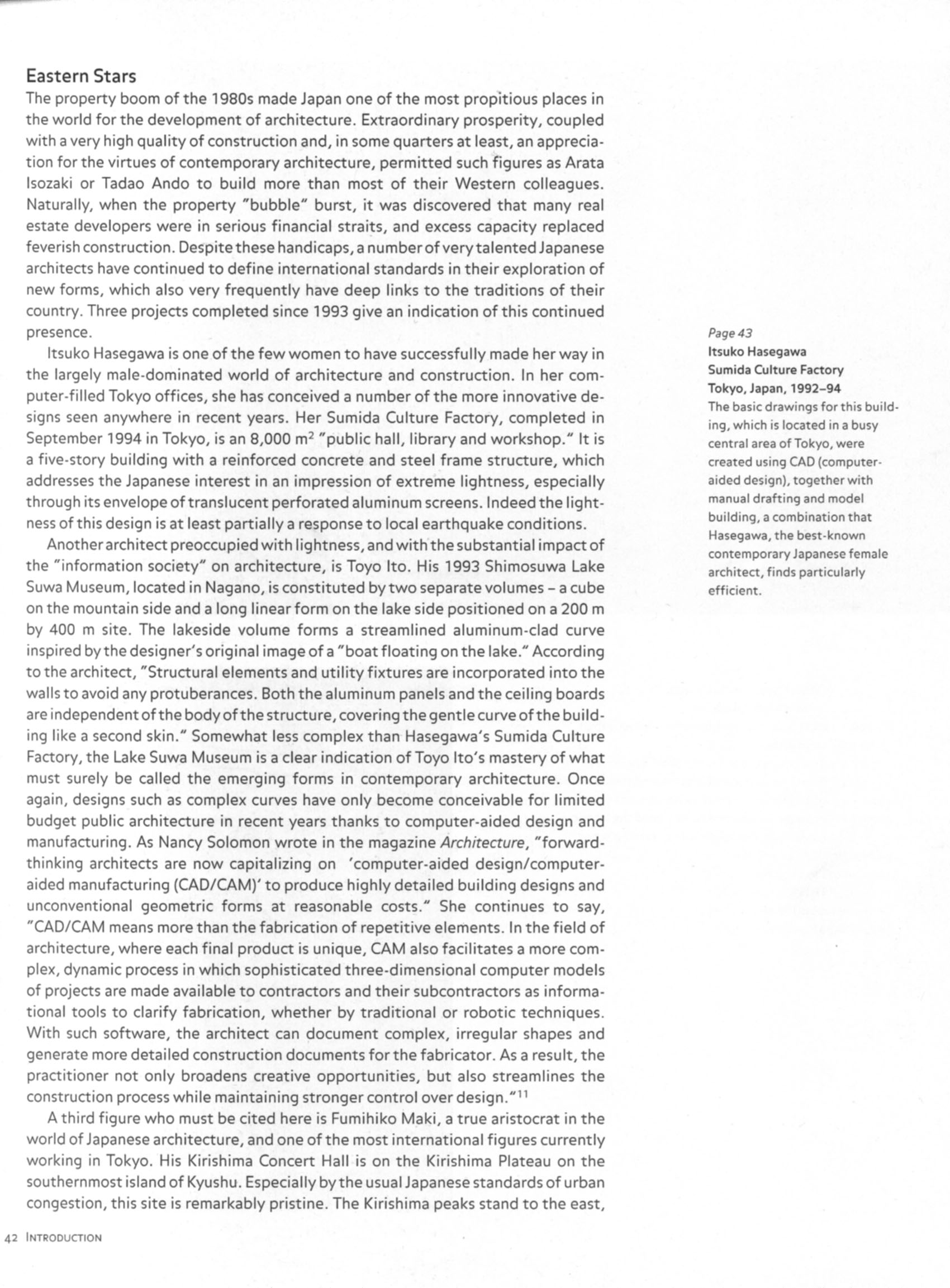20097 New Forms Taschen 039

Eastern Stars
Page 43
Itsuko Hasegawa Sumida Culture Factory Tokyo. Japan, 1992-94
The basie drawings for this build ing, which is located in a busy central area of Tokyo, were created using CAD (computer-aided design), together with manuał drafting and model building, a combination that Hasegawa, the best-known contemporary Japanese female architect, finds particularly efficient.
The property boom of the 1980s madę Japan one of the most propitious places in the world for the development of architecture. Extraordinary prosperity, coupled with a very high quality of construction and, in some quarters at least, an apprecia-tion for the virtues of contemporary architecture, permitted such figures as Arata Isozaki or Tadao Ando to build morę than most of their Western colleagues. Naturally, when the property "bubble" burst, it was discovered that many real estate developers were in serious financial straits, and excess capacity replaced feverish construction. Despitethesehandicaps,a numberof verytalented Japanese architects have continued to define international standards in their exploration of new forms, which also very frequently have deep links to the traditions of their country. Three projects completed sińce 1993 give an indication of this continued presence.
Itsuko Hasegawa is one of the few women to have successfully madę her way in the largely male-dominated world of architecture and construction. In her com-puter-filled Tokyo offices, she has conceived a number of the morę innovative de-signs seen anywhere in recent years. Her Sumida Culture Factory, completed in September 1994 in Tokyo, is an 8,000 m2 "public hall, library and workshop." It is a five-story building with a reinforced concrete and Steel frame structure, which addresses the Japanese interest in an impression of extreme lightness, especially through its envelope of translucent perforated aluminum screens. Indeed the lightness of this design is at least partially a response to local earthquake conditions.
Another architect preoccupied with lightness, and with the substantial impact of the "information society" on architecture, is Toyo Ito. His 1993 Shimosuwa Lakę Suwa Museum, located in Nagano, is constituted by two separate volumes - a cube on the mountain side and a long linear form on the lakę side positioned on a 200 m by 400 m site. The lakeside volume forms a streamlined aluminum-clad curve inspired by the designer's original image of a "boat f loating on the lakę." According to the architect, "Structural elements and utility fixtures are incorporated into the walls to avoid any protuberances. Both the aluminum panels and the ceiling boards are independent of the body of the structure, covering the gentle curve of the building like a second skin." Somewhat less complex than Hasegawa's Sumida Culture Factory, the Lakę Suwa Museum is a elear indication of Toyo lto's mastery of what must surely be called the emerging forms in contemporary architecture. Once again, designs such as complex curves have only become conceivable for limited budget public architecture in recent years thanks to computer-aided design and manufacturing. As Nancy Solomon wrote in the magazine Architecture, "forward-thinking architects are now capitalizing on 'computer-aided design/computer-aided manufacturing (CAD/CAM)' to produce highly detailed building designs and unconventional geometrie forms at reasonable costs." She continues to say, "CAD/CAM means morę than the fabrication of repetitive elements. In the field of architecture, where each finał product is unique, CAM also facilitates a morę com-plex, dynamie process in which sophisticated three-dimensional Computer models of projects are madę available to contractors and their subcontractors as informa-tional tools to clarify fabrication, whether by traditional or robotic techniques. With such software, the architect can document complex, irregular shapes and generate morę detailed construction documents for the fabricator. As a result, the practitioner not only broadens creative opportunities, but also streamlines the construction process while maintaining strongercontrol over design."11
A third figurę who must be cited here is Fumihiko Maki, a true aristocrat in the world of Japanese architecture, and one of the most international figures currently working in Tokyo. His Kirishima Concert Hall is on the Kirishima Plateau on the southernmost island of Kyushu. Especially by the usual Japanese standards of urban congestion, this site is remarkably pristine. The Kirishima peaks stand to the east,
42 Introduction
Wyszukiwarka
Podobne podstrony:
88110 New Forms Taschen 041 Pages44/45 Itsuko Hasegawa Sumida Culture Factory Tokyo, Japan
New Forms Taschen 092 Mario Borta San Francisco Museum of Modem Art San Francisco, Califomia. 1990-9
69129 New Forms Taschen 059 Pages 64/6 S Hiroshi Hara Umeda Sky City Kita-ku, Osaka, Japan
86027 New Forms Taschen 011 Zaha Hadid Vitra Fire Station Weil am Rhein, Germany, 1988-93 Part of th
New Forms Taschen 056 Pages 60/61 Santiago Calatrava lyon-Satolas Railway Station Lyon, Fr
New Forms Taschen 102 Page U O Massimiliano Fuksas Montaigne University Art School Buildmg
New Forms Taschen 140 Page 151 Massimiliano Fuksas Entrance to Grotto Niaux, Franco. 1988-93&nb
więcej podobnych podstron